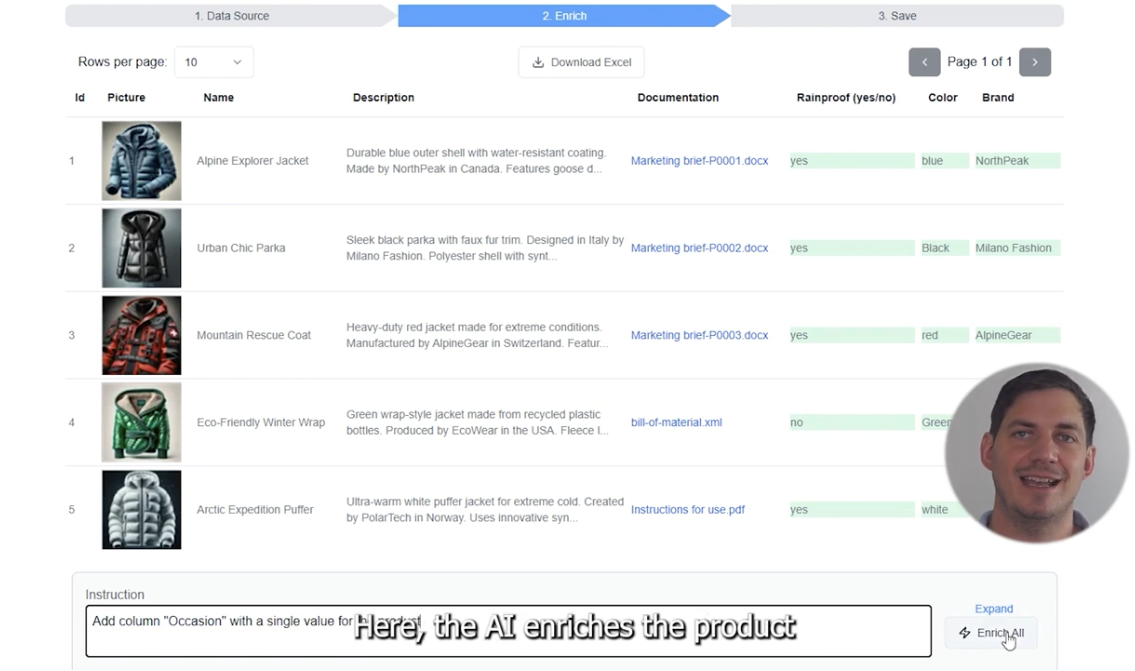Choosing the Right PIM Platform
Selecting the right PIM system requires understanding how different platforms approach data modeling, attribute management, and business entity support. This comprehensive comparison analyzes leading PIM systems based on verifiable technical capabilities documented by vendors.
Each platform takes a distinct approach to organizing product data, from traditional product-centric models to flexible entity-agnostic architectures. Understanding these differences helps organizations choose platforms that align with their specific data complexity and business requirements.
Data Model Approaches
Entity-Agnostic Systems
True entity-agnostic platforms treat all data as first-class objects. This means that a 'Product' is not a special, hardcoded entity. Instead, you can model Products, Suppliers, Materials, or any other business object using the same set of rich tools, and create complex relationships between them.
Inriver: A strong example of this approach, Inriver's model is built on configurable entities from the ground up.
Syndigo: Another strong example, Syndigo's platform is based on the powerful, multi-domain 'Thing' model inherited from Riversand.
Pimcore: As an open-source framework, Pimcore's 'Object Class' system is also truly entity-agnostic. It provides the tools to build a comprehensive MDM solution where any object can be defined with the same depth, but it requires developer expertise to implement this vision.
Product-Centric Systems
These platforms are primarily designed to manage Products and their direct variants. While they can often handle other data, it is typically in a supporting role, often through simpler reference lists or as a specialized type of product.
Akeneo: A classic example of a product-centric model, with a focus on 'Families' that define product attributes. It supports custom entities via 'Reference Entities,' but these are less capable than the core product entities.
Salsify: Uses a flexible JSON-schema model that is highly optimized for retail product data and its syndication. Other data is handled via simple key-value 'Entities,' which are not as rich as the core product object.
Struct: Built around 'Product Structures' that define product and variant blueprints. It can model other data using 'Global Lists' with complex attributes, but the system's core architecture is product-focused.
Bluestone: This MACH-aligned platform uses 'Product Types' and flexible JSON documents as its foundation. While powerful, other business objects must be modeled as a specialized Product Type, making it inherently product-centric. Core functions like 'Assets' and 'Tasks' are hardcoded relationships to products, not configurable attributes.
"The fundamental difference between PIM systems lies in their data modeling approach. Entity-agnostic systems like Inriver and Syndigo provide maximum flexibility, while product-centric systems like Akeneo offer simpler implementation for traditional catalog scenarios."
Custom Entity Support Analysis
Full Custom Entity Capabilities
Inriver: Unlimited custom entity types with identical modeling capabilities to products. Any business object can have full attribute richness, relationships, and workflow support without limitations.
Syndigo: Thing-based model supports any domain with cross-domain relationships. Customers, orders, suppliers, and locations have identical modeling capabilities to products.
Pimcore: Object Classes provide complete custom entity modeling with all attribute types, relationships, and workflow capabilities. Requires technical configuration but offers full flexibility once set up.
Limited Custom Entity Support
Akeneo: Reference Entities (Enterprise Edition only) provide basic custom entity support but lack workflow capabilities, completeness scoring, and advanced validation features available to products.
Struct: Global Lists enable custom entities with complex attributes but are primarily designed for supporting data rather than primary business objects.
Bluestone: Custom entities must be modeled as Product Types using the JSON document structure. Tasks are hardcoded entities specifically for workflow management.
Salsify: Custom entities limited to simple key-value referentials ("Entities") for code lists and basic supporting data without rich attribute modeling.
API Capabilities Summary
Authentication & Performance
Inriver: API key authentication with comprehensive .NET SDK. Rate limits per tenant (500 req/min) with isolated infrastructure.
Akeneo: OAuth2 authentication with extensive search operators. Rate limiting in SaaS with headers for monitoring.
Salsify: Bearer token authentication with sophisticated filtering. Bulk operations up to 10,000 records with comprehensive operators.
Pimcore: API key authentication with both REST and GraphQL endpoints. DataHub enables channel-specific transformations.
Struct: API key authentication with JSON Query DSL. Bulk operations up to 5,000 entities per call. Middleware recommended for performance.
Bluestone: API key authentication with MACH-certified architecture. Webhooks with HMAC signatures and Extension Hub microservices.
Syndigo: OAuth2 with comprehensive bulk operations. EventHub streams and GraphQL federation for composable architecture.
Search & Filtering
All platforms support advanced filtering with platform-specific query languages. Akeneo and Syndigo offer the most comprehensive search operators, while Inriver's search integrates with workflow-based workareas.
API Deep Dive: How PIMs Search by SKU
A simple product search by SKU reveals fundamental architectural differences between PIM systems. Here's a comparison of how each platform handles this common operation.
Query-Driven Systems
Inriver: Uses a query-first approach where search criteria are sent in the request body of a POST request. This allows for complex, multi-faceted queries but requires a two-step process to first get entity IDs and then fetch the data.
Struct: Also uses a POST request to a dedicated /search endpoint with a JSON Query DSL in the body. This is powerful but differs from standard REST patterns.
RESTful Query Parameters
Salsify & Akeneo: Both use a standard RESTful GET request with a filter parameter in the URL. This is an intuitive and widely understood approach for simple lookups.
Bluestone: Uses Elasticsearch for its search functionality, allowing for powerful filtering via query parameters in a GET request. This is both flexible and follows RESTful conventions.
Syndigo: Leverages a filter query parameter in a GET request, similar to Salsify and Akeneo, for straightforward attribute-based searches.
RPC-Style & Proprietary Queries
Pimcore: The GraphQL API, available through the DataHub bundle, is the primary method for searching. However, it's often unclear which API capabilities are included in the open-source version versus the enterprise edition, making it difficult to establish a best practice without evaluating licensing.
Perfion: Uses a proprietary XML-based query language sent to a web service endpoint. This approach is less standardized and can be more cumbersome to integrate with modern systems.
"Platform selection should align with your data complexity and business model. Simple product catalogs work well with Akeneo or Salsify, while complex B2B scenarios with custom entities benefit from Inriver or Syndigo's flexibility."
Deployment and Architecture Considerations
Cloud-Native Platforms
Bluestone: MACH-certified with isolated tenant provisioning on AWS. Multi-region deployment with microservices architecture.
Struct: Azure-native with single-tenant containers. Strong integration with Microsoft business applications and Azure services.
Syndigo: Global infrastructure across US-East, EU-West, and APAC with enterprise-grade security and compliance.
Flexible Deployment Options
Pimcore: Self-hosted or cloud deployment with certified hosting partners. Symfony-based architecture provides deployment flexibility.
Akeneo: Community Edition for self-hosting, Serenity SaaS, or Enterprise on-premise. Docker containers available for development.
SaaS-Only Platforms
Inriver: Azure SaaS infrastructure with comprehensive security and scalability. Enterprise-focused deployment model.
Salsify: Enterprise SaaS with focus on retail syndication and marketplace integration. No self-hosted options.
Modern PIM implementations benefit from AI-powered content generation and intelligent automation workflows.
Platform Selection Criteria
Data Complexity Assessment
Choose entity-agnostic platforms (Inriver, Syndigo) for complex B2B scenarios requiring custom entities with full capabilities. Product-centric platforms (Akeneo, Salsify) work well for traditional e-commerce catalogs.
Channel Requirements
Retail-focused businesses benefit from Salsify's built-in syndication or Syndigo's extensive recipient network. Multi-channel B2B scenarios may prefer Inriver's workflow capabilities or Pimcore's integrated content management.
Technical Resources
Open-source options (Akeneo, Pimcore) require development resources but offer customization flexibility. SaaS platforms provide faster implementation but less customization capability.
Integration Needs
Consider existing technology stack integration requirements. Struct works well with Microsoft environments, while Pimcore integrates naturally with Symfony-based systems.
Future Scalability
Evaluate platforms based on growth requirements including product volumes, new channels, and international expansion. MACH-certified platforms like Bluestone offer composable architecture benefits.
"There's no single 'best' PIM system - success depends on matching platform capabilities to specific business requirements. The key is understanding your data model needs, channel complexity, and team capabilities before making a selection."
Implementation Guidance
This comparison provides a foundation for PIM platform evaluation based on technical capabilities and architectural approaches. Each platform offers distinct advantages depending on business requirements, data complexity, and organizational needs.
Successful PIM implementation requires careful analysis of current data challenges, future growth requirements, and team capabilities. The platforms analyzed here represent different philosophical approaches to product information management, from traditional catalog-focused systems to comprehensive Master Data Management solutions.
Organizations should conduct proof-of-concept implementations with shortlisted platforms to validate technical assumptions and user experience expectations. The right PIM system will align with your data model requirements while providing room for future growth and adaptation.
Ready to Choose Your PIM?
Learn how to evaluate PIM systems systematically with our comprehensive selection guide covering requirements analysis, vendor evaluation, and implementation planning.
Read Selection Guide

